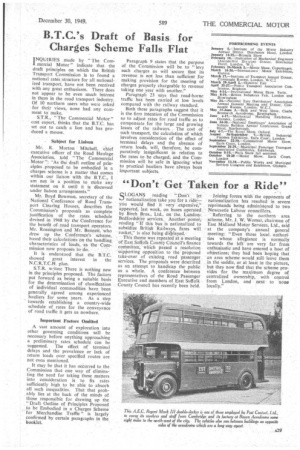B.T.C.'s Draft of Basis for Charges Scheme Falls Flat
Page 31

If you've noticed an error in this article please click here to report it so we can fix it.
INQUIRIE,S made by "The Cornmercial Motor" indicate that the draft principles on which the British Transport Commission is to found a national rates structure for all nationalized transport, have not been received with any great enthusiasm. There does not appear to be even much interest in them in the road transport industry. Of 10 northern users who were asked for their views, none had any comment to make.
S.T.R., "The Commercial Motor" cost expert, thinks that the B.T.C. has set out to catch a lion and has produced a mouse.
Subject for Liaison Mr. R. Morton Mitchell, chief executive officer of the Road Haulage Association, told "The Commercial Motor ": "As the draft outline of principles proposed to be embodied in a charges scheme is a matter that comes within our liaison with the B.T.C., I am not in a position to make any statement on it until it is discussed under liaison arrangements."
Mr. Boyd Bowman, secretary of the National Conference of Road Transport Clearing Houses, describes the Commission's proposals as complete justification of the rates schedule devised in 1948 by the Conference for the benefit of-road transport operators. Mr. Rossington and Mr. Bennett, who drew up the Conference's scheme, based their calculations on the handling, characteristics of loads, as the Com- mission now proposes to-do.
It is understood that the B.T.C. showed great interest in the N.C.R.T.C.H. plan.
S.T.R. w:ites: There is nothing new in the principles proposed. The factors put forward as being a suitable basis for the determination of classification of individual commodities have been generally agreed among experienced hauliers for some years. As a step towards establishing a country-wide schedule of rates for the conveyance of road traffic it gets us nowhere.
Important Factors Omitted A vast amount of exploration into other governing conditions will be necessary before anything approaching a preliminary rates schedule can be suggested. The effect of terminal delays and the prevalence or lack of return loads over specified routes are not even mentioned.
It may be that it has nee' urred to the Commission that one way of eliminating the need for taking these matters into consideration is to fix rates sufficiently high to be able to absorb all such inequalities. That that prob. ably lies at the back of the minds of those responsible for drawing up the "Draft Outline of Principles Proposed to be Embodied in a Charges Scheme for Merchandise Traffic" is largely confirmed by certain paragraphs in the booklet. Paragraph 9 states that the purpose of the Commission will be to "levy such charges as will secure that its revenue is not less than sufficient for making provision for the meeting of charges properly chargeable to revenue taking one year with another."
Paragraph 21 says that road-borne traffic has been carried at low levels compared with the railway standard.
Both these paragraphs suggest that it is the firm intention of the Commission so to adjust rates for road traffic as to compensate for the large and growing losses of the railways. The cost of such transport, the calculation of which involves consideration of the effect of terminal delays and the absence of return loads, will, therefore, be comparatively insignificant in relation to the rates to be charged, and the Commission will be safe in ignoring what to practical hauliers have always been important subjects.




















































































